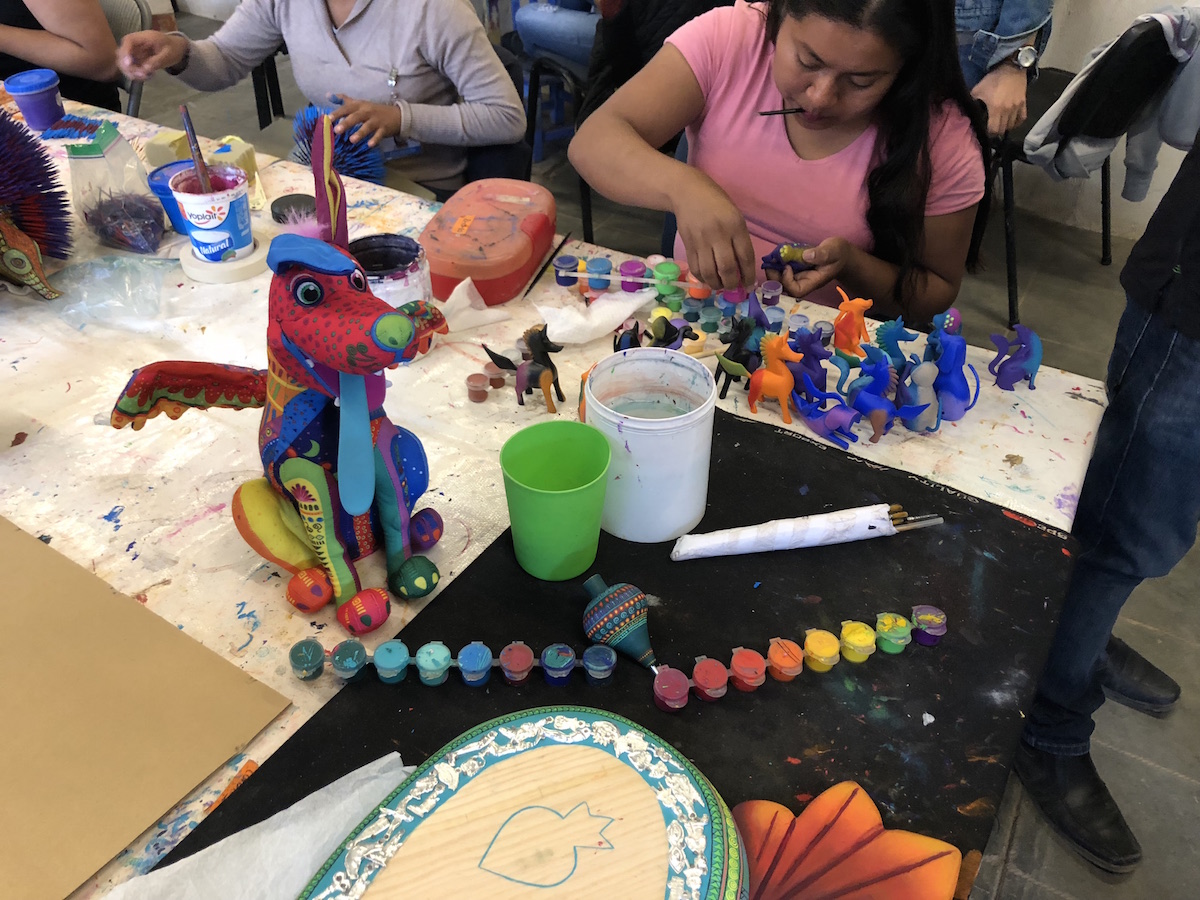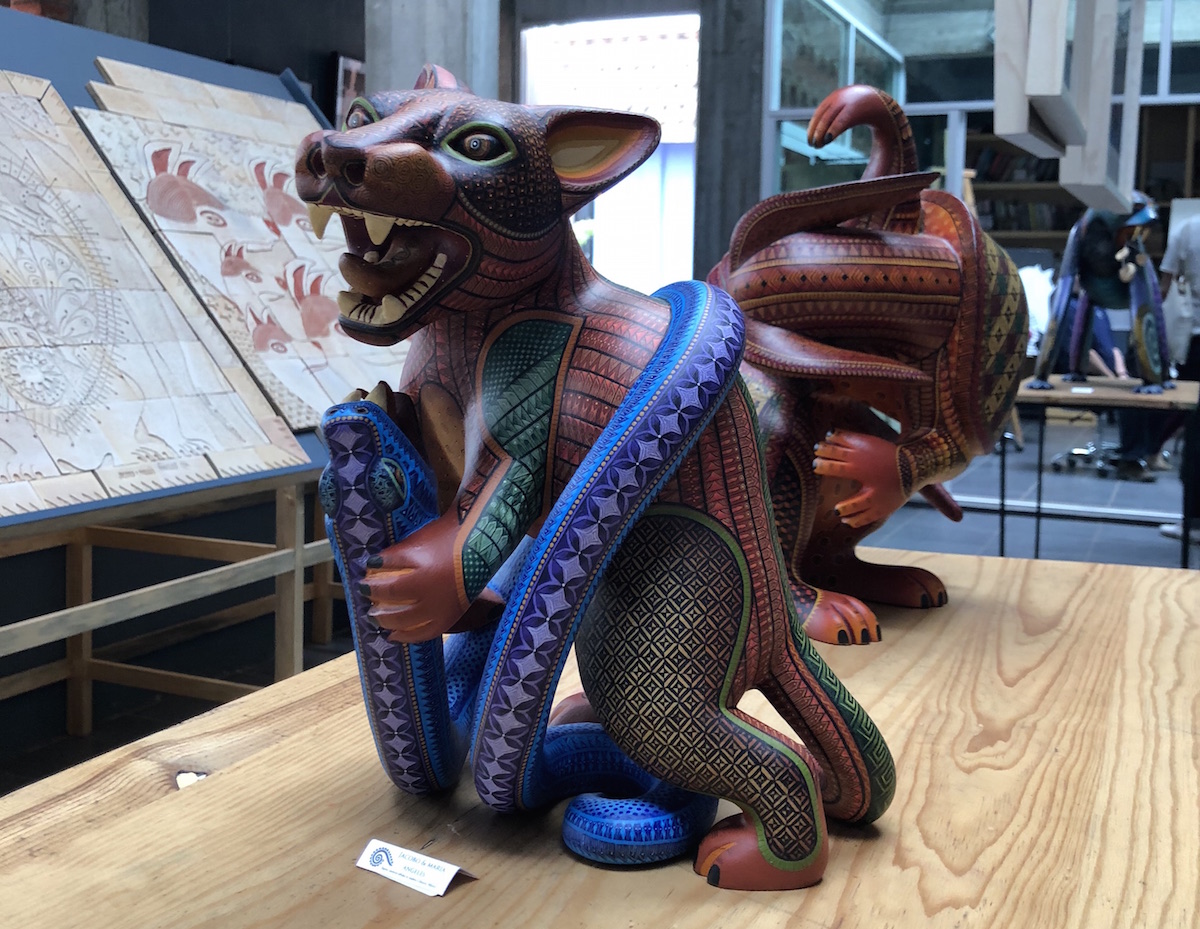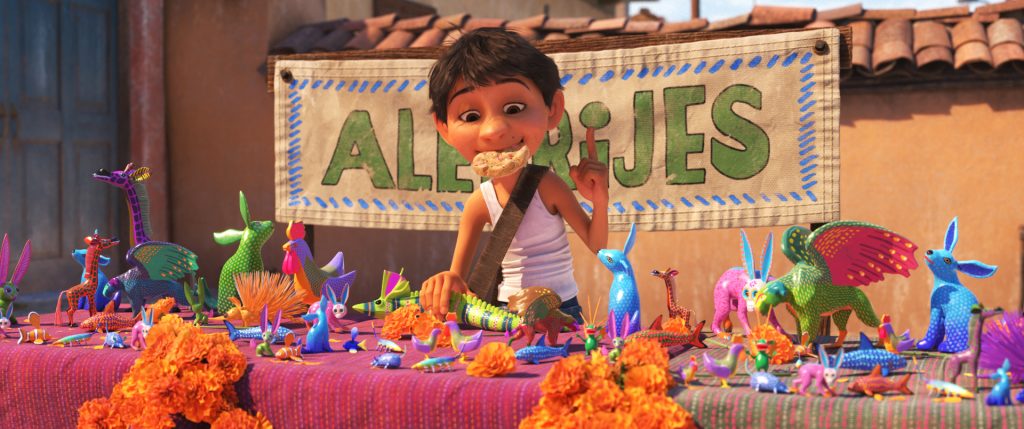There’s a blink-and-you’ll-miss-it moment when the young protagonist of Pixar’s Coco Miguel is walking down the streets of his village of Santa Cecilia and passes a table full of small colorful figurines. Actually, if you pause at the right time, not only can you spot a small Nemo among these handmade trinkets depicting fantastical animals, but Pepita as well, the imposing ram-horned giant cat with wings that we later learn helps Miguel’s great-great-grandmother in the Land of the Dead. Called alebrijes, these artisan artifacts became integral to the storytelling of this Día de Muertos tale. And we should all thank married couple Jacobo Angeles and María del Carmen Mendoza.
It was their workshop in San Martín Tilcajete in the Oaxaca region of Mexico that eventually won over the Pixar filmmakers working on Coco and inspired them to incorporate alebrijes into their film. Director Lee Unkrich and his team saw in them a chance to further deepen the Mexico they were hoping to capture on screen. Moreover, in talking with Jacobo and María, the Coco filmmakers found not just an old tradition being rethought for a new generation but a welcome bit of mythology that connected these fantasy creatures with Zapotec beliefs about death and protection.
Founded in 1994 shortly after they were married, their workshop ‘Jacobo & María Angeles‘ has managed to bring worldwide recognition to the artistry of this most Mexican of crafts. But even as they champion new ways of tinkering with decades-long traditions of how to make alebrijes (incorporating new elements as well as new designs), their process remains quite rudimentary, honoring the artisanship of the region.
Many of the alebrijes created at their workshop are carved out of copal wood. Some are small enough that you can hold them in your hand, while others make for striking statement pieces better admired at art galleries. Regardless of their size they are all meticulously produced: they are hand-carved from original designs and later painted by hand by one of the many members of Jacobo and Maria’s workshop. The key to these mythical and colorful figures, as it turns out, is patience. After they’re carved, they need to be dried — a process that can take up to a year, with monthly coats of oil to help make sure there’s no humidity left in the wood before they’re decorated. The designs in the alebrijes, which borrow from Zapotec cosmology and iconography, can take weeks to finish. More impressive even is the fact that many of the colors and paints used are naturally sourced; the many shades of red, orange and indigo you see are created from lemons, pomegranates, flowers, and seeds.
Part of what sets the Jacobo & Maria Angeles’ workshop apart is their commitment to give back to the communities around them. Not only are they part of a campaign to help reforest the surrounding areas to help offset the copal lumber they use for their pieces, but they work closely with the young men and women of the area who want to be schooled in the carving and painting aspect of the craft. Initially, they wanted to offer a positive and hopeful alternative to kids in the Oaxaca region to help offset the violence that riddled their everyday life. Art and artisan trades became a way to shed some light in what was then a dark period for Mexico. They’ve since seen the tides change. Their workshop is now a tourist destination and a first-rate school for those eager to follow in their footsteps.
For Maria, they wanted to make sure the gift of making alebrijes would not be lost to a new generation. That’s what compelled them to nurture new talent with their school. “The purpose was to create a legacy, to reclaim this trade.” Moreover, given that they’re now catering to and including over 12 different pueblos in their classes, they have created a network of artisans that teach and learn from one another. Now, with Coco playing all around the world, the couple is proud to see their craftsmanship and their culture celebrated.

Not that they weren’t hesitant about what that kind of responsibility would be. Like many others in Mexico and abroad, Maria was initially wary when the project was first announced. She worried the film would not be able to truly capture the very curious way Mexicans think about death. “For, no matter how much people elsewhere fear death, we enjoy it,” she told Remezcla. “As a Mexican, Oaxacana, Zapoteca, I understand the feeling of the Día de Muertos. I live it. Its colors, its flavors, its smells, its joy even. But I was like, how will they translate that on screen?” Thankfully, when she finally saw the film, she realized she didn’t have to worry. Coco succeeds, Maria stressed, in how it’s able to represent the festive atmosphere surrounding death in Mexico, and especially in the Oaxaca region.
Jacobo, for his part, loved the way the filmmakers were able to marry the mythology of the alebrijes with the larger concept of Day of the Dead. While these chimeric animals are attributed to the feverish dreams of Pedro Linares, their Oaxacan offshoots are most closely associated with Manuel Jiménez Ramírez, a native of San Antonio Arrazola. It was he who combined the idea of these beasts with the concept of the nahual. As Jacobo and Maria explain on their website, “The nahual is a protector who defines your personality depending on the year and day you are born.” Figures of the tonas, the animals which represent the Zapotec calendar, had long been made in Oaxaca, and they’ve now come to be thought in conjunction with alebrijes. That image of these creatures as protectors is what prompted the Pixar crew to dream up a world where the alebrijes could serve as guides in the Land of the Dead.

The ability to have honored old traditions and renewed them with revered veneration is what most impressed Jacobo and María about Coco. But more than that, they were both ecstatic that here was a film that put Mexican artisan culture front and center, and celebrated the best of what Mexico has to offer.
“What I see is that Coco was able to put Mexican culture in a very dignified way on the screen. Coco came to give a firm message to the world: that Mexico is alive, that Mexico isn’t just sensationalized headlines. That Mexico has a lot of sweetness, and, of course, a lot of love.”
The interview with Jacobo and Maria Angeles was conducted in Spanish and their answers have been translated into English by the author for Remezcla.







